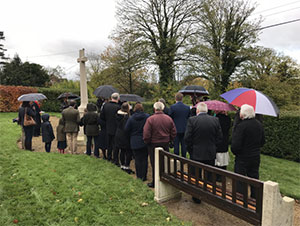

 70 years ago, at 10.30am on Sunday 12th November 1950, Captain Guy Benson unveiled the new war memorial during a special service of dedication conducted by Reverend Vernon Thomas and held at the site to commemorate those soldiers who had died during both world wars. Captain Fielding-Johnson (Manor Farm) and Captain Benson (Compton Bassett House), set up a village planning committee for the purpose of erecting the memorial. Villagers contributed to a fund but the majority was donated by the two captains.
70 years ago, at 10.30am on Sunday 12th November 1950, Captain Guy Benson unveiled the new war memorial during a special service of dedication conducted by Reverend Vernon Thomas and held at the site to commemorate those soldiers who had died during both world wars. Captain Fielding-Johnson (Manor Farm) and Captain Benson (Compton Bassett House), set up a village planning committee for the purpose of erecting the memorial. Villagers contributed to a fund but the majority was donated by the two captains.
The location for the memorial is deliberate; its elevated setting allows views over an idyllic and unhindered landscape that serves well as a place of contemplation; it may also be no coincidence that the furthest point of reference on the horizon lies the former RAF base at Lyneham
 The location for the memorial is deliberate; its elevated setting allows views over an idyllic and unhindered landscape that serves well as a place of contemplation; it may also be no coincidence that the furthest point of reference on the horizon lies the former RAF base at Lyneham
The location for the memorial is deliberate; its elevated setting allows views over an idyllic and unhindered landscape that serves well as a place of contemplation; it may also be no coincidence that the furthest point of reference on the horizon lies the former RAF base at Lyneham
Captain Fielding-Johnson lost his only son Hugh and step-son Diccon Earle in the Second World War and the verse inscribed on the rear panel of the memorial is taken from the sonnet 'Say Not That Beauty' composed by English poet Robin Flower:
Not with the earthly eye or fleshly ear,
But lifted high above mortality,
We see at last the eternal hills,
and hear the sighing of the universal sea;
And kneeling breathless in that holy place
A 2004 article by Jack Watkins for the War Memorials Trust Bulletin describes how the building of the memorial came to fruition:
'There may be grander War Memorials than the stone cross in the village of Compton Bassett in Wiltshire, but few can occupy a more evocative setting. Beyond the narrow lane at the foot of the steps leading up to it, the ground falls away, amidst the trees and hedgerows, to rich green meadows grazed by herds of dairy cows. It is the sort of 'Forever England' landscape evoked by war poets.
"It is a wonderful view and a nice place to come and think your thoughts, even if some of them are painful ones", reflects Alan Lewis, a veteran of the D-Day landings at Arrowmanches. He stands on the steps with his friend, Les Smith, two men steeped in the village and its dairy-farming traditions. Moments later, up rolls Jim Taylor; like the other two, he was present at the memorial's unveiling in 1950 and carries a photograph of the ceremony.
Of the two local military men, Captains Benson and Fielding-Johnson, Jim has some wry memories of the latter. "He wouldn’t put money into it unless the villagers got involved first. He had a little rubber dinghy set up and, for every sixpence we threw in, he'd double it".
The Compton Bassett memorial is constructed from Portland stone and is Grade II listed, having been judged in 2002 to be an uncommon example, meriting its status of special architectural and historic interest. It is designed after Sir Reginald Blomfield's Cross of Sacrifice design in 1918, being a plain cross with a bronze longsword, blade pointed downward, on the front. Compton Bassett's version has a sword carved as a recessed shape, rather than having a sculpture fixed to the face. It is situated on an octagonal plinth, at the top of a flight of twelve steps from the street.
Further information pleas ecall Laurie Waite on 01249 811076